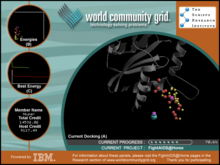FightAIDS@Home

FightAIDS@Home ("Fight AIDS at home") is a distributed computing project for internet-connected home computers, operated by the Olson Laboratory at The Scripps Research Institute. It aims to use biomedical software simulation techniques to search for ways to cure or prevent the spread of AIDS and HIV.
Methods
Olson's target is HIV protease, a key molecular machine of the virus that when blocked stops it from maturing. These blockers, known as "protease inhibitors", are thus a way of avoiding the onset of AIDS and prolonging life. The Olson Laboratory is using computational methods to identify new candidate drugs that have the right shape and chemical characteristics to block HIV protease. This general approach is called structure-based drug design, and according to the National Institutes of Health's National Institute of General Medical Sciences, it has already had a dramatic effect on the lives of people living with AIDS.
FightAIDS@Home makes use of the AutoDock software, which tests how well a particular molecule binds to the HIV-1 protease.
History
It was originally implemented using a distributed computing software infrastructure provided by Entropia. However, since May 2003 FightAIDS@Home has not been associated with Entropia,[1] and on November 21, 2005, the project moved to World Community Grid and the Entropia software was abandoned.[2]
Scripps Research Institute published its first peer-reviewed scientific paper about the results of FightAIDS@Home on April 21, 2007.[3] This paper explains that the results up to that point will primarily be used to improve the efficiency of future FightAIDS@Home calculations.[4]
On February 3, 2010, the project announced it found two compounds that make a completely new class of AIDS-fighting drugs possible: "two compounds that act on novel binding sites for an enzyme used by the human immunodeficiency virus (HIV), the virus that causes AIDS. The discovery lays the foundation for the development of a new class of anti-HIV drugs to enhance existing therapies, treat drug-resistant strains of the disease, and slow the evolution of drug resistance in the virus."
System requirements
The minimum system requirements to run FightAIDS@home are:[5]
| Processor | 550 MHz |
|---|---|
| Memory | 250 MB |
| Hard drive | 600 MB (50 MB free) |
| Screen resolution | 8-bit graphics at 800×600 |
| Internet connection | 40 kbit/s |
With distributed computing every computer added accelerates the project, while the program has little impact on the PC it is installed on as the calculation process is running at minimum priority in the background.
Publications
Chang, Max W.; Lindstrom, William; Olson, Arthur J.; Belew, Richard K. (2007). "Analysis of HIV Wild-Type and Mutant Structures via in Silico Docking against Diverse Ligand Libraries". J. Chem. Inf. Model. 47 (3): 1258–1262. doi:10.1021/ci700044s. PMID 17447753
See also
References
- ↑ "Worthy Cause: Fight AIDS At Home Computer Project". FuturePundit. 2003-12-01. Retrieved 2007-08-08.
- ↑ "FightAIDS@Home". The Scripps Research Institute. Retrieved 2007-08-08.
- ↑ Chang, Max W.; William Lindstrom, Arthur J. Olson, and Richard K. Belew (2007-04-21). "Analysis of HIV Wild-Type and Mutant Structures via in Silico Docking against Diverse Ligand Libraries". J. Chem. Inf. Model. American Chemical Society. doi:10.1021/ci700044s. Retrieved 2007-07-30.
- ↑ "FightAIDS@Home News Volume 3". The Scripps Research Institute. 2007-05-10. Retrieved 2007-07-30.
- ↑ "System Requirements". Help. World Community Grid. Retrieved 2007-08-08.
External links
| Wikimedia Commons has media related to FightAIDS@Home. |
- World Community Grid - Research - FightAIDS@Home
- FightAIDS@Home at Scripps
- World Community Grid Targets AIDS in Giant Research Effort
| ||||||||||||||||||||